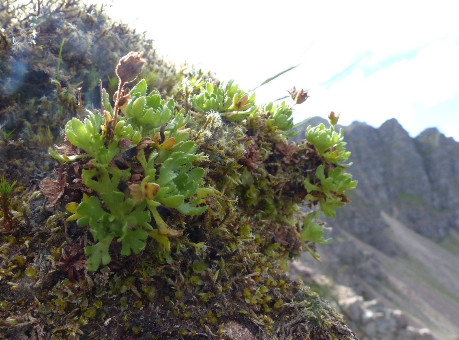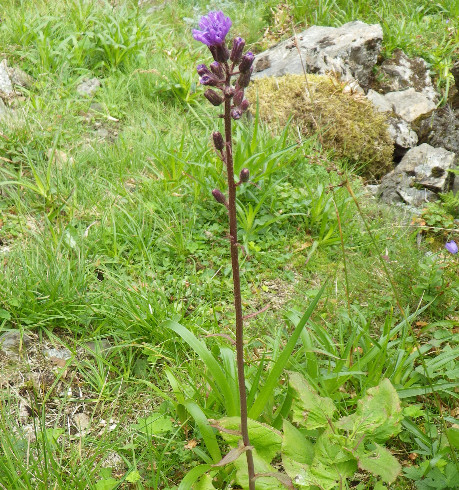Wednesday 17th July 2019, 1:47pm
Botanists from the Royal Botanic Gardens in Edinburgh are renewing an appeal for climbers and walkers to help them in locating rare and endangered plants in Scotland’s mountains.
Because many of these increasingly hard to find plants grow in cliffs and steep ground, sometimes climbers and scramblers are the only people who ever see them.
And now the plea has gone out for people who see particular plants to report the sightings so that they can be better studied.
Gavin Powell and Chris Ellis, of the Royal Botanical Gardens Edinburgh, have written:
Anyone who has survived a mountain storm cannot fail to be impressed by the plants and animals clinging to existence under frequent extreme conditions. There are many British plants found exclusively in our mountains, not just eking out their existence, but making a home of high and remote places. Such plants face many threats, including climate change. Seasonal weather seems to be increasingly erratic, a general trend for milder winters has left some of Scotland’s rarest mountain plants vulnerable.”
Of particular interest to botanists are the tenacious alpine plants, relics of Scotland’s post-glacial landscape that emerged at the end of the last ice age. A species such as tufted saxifrage (Saxifraga cespitosa) struggles to compete when more vigorous surrounding vegetation is not suppressed by late lying snow, while the alpine blue sow-thistle (Cicerbita alpina) appears to produce fertile seeds only in exceptional ‘alpine’ years with long winters and hot summers. Furthermore, overgrazing has forced both plants to retreat to increasingly inaccessible mountain ledges, cliff faces and steep gullies.

Saxifraga cespitosa on Liathach.
While alpine blue sow-thistle and tufted saxifrage favour areas of deeper snow, other species occur in less protected locations, on wind-blasted spurs and ridges that tend to be blown clear of snow, and which are fully exposed to the winter elements. A lichen, alpine sulphur tresses (Alectoria ochroleuca), is an example of a species declining where snow-cover is deeper and longer-lying, but surviving in the open. This is one of several lichens that can be found growing intertwined with plants such as heather or crowberry. It is known from only a few isolated populations, and is threatened by climate change, especially by the more vigorous growth of other plants during milder winters. All three species have special conservation designation, protected under Schedule 8 of the Wildlife and Countryside Act 1981 and a conservation priority for the Cairngorms Nature Action Plan.
Monitoring is a key step in helping these plants and lichen to survive into the future. Because they grow in remote mountain locations, conservationists remain unsure of exactly how many populations exist, and where monitoring and protection should be focussed.
Nowadays only observant climbers and hillwalkers are likely to encounter these three plants – and they can help by making new discoveries. For example, alpine blue sow-thistle was thought to be restricted to two sites low down Lochnagar’s north face, on the west side of the Black Spout couloir. However, small pockets were once found across Lochnagar’s north face at a range of altitudes, and in 2017 it was rediscovered above 1000m, spotted by a Scottish Natural Heritage officer walking along the top on his day off. This small clump was growing just 30m away from some belay tat. Climbers and scramblers would have had a better view of this site than professional botanists searching with binoculars!
To help with Scotland’s plant conservation, the Royal Botanic Garden Edinburgh (RBGE) is appealing to Mountaineering Scotland’s members to report sightings of these three plants.
Cicerbita alpina - alpine blue sow-thistle - has distinctive triangular lobed leaves, and tall erect stems 50- 200cm high, which are topped with a cluster of violet-blue flowers between July and September. Any new reports of where climbers on Lochnagar’s north face may have seen this growing would highlight which areas to survey with RBGE’s drone, as flight time is limited by short battery life.
Hillwalkers and scramblers might be lucky enough to see Saxifraga cespitosa – tufted saxifrage - when on Ben Alder, Ben Avon, Ben Nevis or in the mountains of Torridon and northern Skye. Tufted saxifrage grows close to the ground in small tussocks, in a mossy sort of fashion above 800m. It has fleshy oblong-shaped hairy leaves with small greenish white flowers appearing between May and July.
Alectoria ochroleuca – alpine sulphur tresses - has long, thin (c. 0.5-2 mm wide) and sprawling yellow branches, that are contorted, giving it the distinct appearance of ‘silly string’. It grows throughout the year, and is most likely to be observed in areas of wind-clipped heathland, typically between about 750 and 950 metres altitude, on mountains in and surrounding the Cairngorms. There are outlying records on Orkney, and historic records from mountains further north and west than its current range. Clear, sharp photographs would be especially useful for a positive identification.
It would be a tremendous help if all suspected sightings could be photographed, so long as this did not involve damaging the plants and lichen and their habitat. For the alpine blue sow-thistle and tufted saxifrage, RBGE would be very grateful if it is possible to count the number of plants and how many are in flower without disturbing them or putting yourself at risk. Sightings of all species would ideally be accompanied by GPS coordinates or an OS map six figure grid reference of the location. However, even knowing the name of the mountain, climbing route and a description would still be useful.
More information is available on the RBGE website.
Details of sightings and photographs can be sent to raremountainplants@rbge.org.uk

Cicerbita alpina.